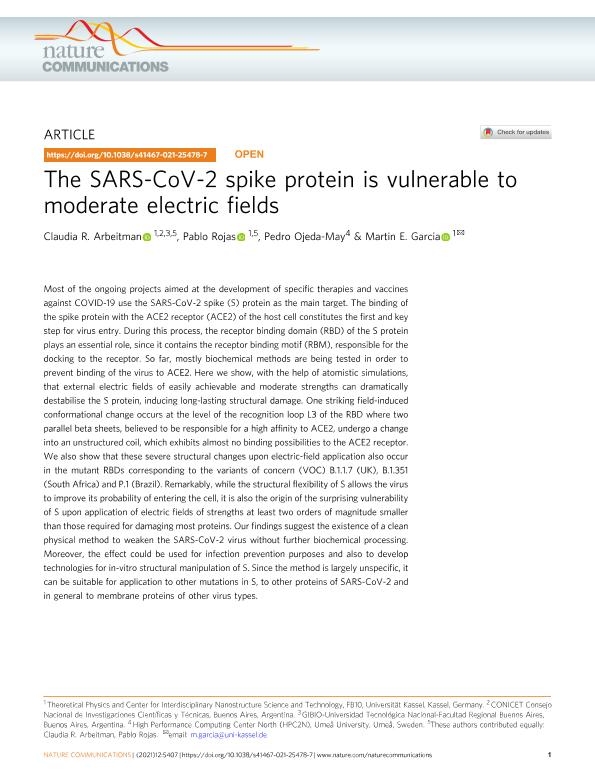Mostrar el registro sencillo del ítem
dc.contributor.author
Arbeitman, Claudia Roxana

dc.contributor.author
Rojas, Pablo
dc.contributor.author
Ojeda May, Pedro
dc.contributor.author
García, Martin E.
dc.date.available
2022-01-11T17:53:51Z
dc.date.issued
2021-09
dc.identifier.citation
Arbeitman, Claudia Roxana; Rojas, Pablo; Ojeda May, Pedro; García, Martin E.; The SARS-CoV-2 spike protein is vulnerable to moderate electric fields; Springer Nature; Nature Communications; 12; 5407; 9-2021; 1-13
dc.identifier.issn
2041-1723
dc.identifier.uri
http://hdl.handle.net/11336/149940
dc.description.abstract
Most of the ongoing projects aimed at the development of specific therapies and vaccines against COVID-19 use the SARS-CoV-2 spike (S) protein as the main target. The binding of the spike protein with the ACE2 receptor (ACE2) of the host cell constitutes the first and key step for virus entry. During this process, the receptor binding domain (RBD) of the S protein plays an essential role, since it contains the receptor binding motif (RBM), responsible for the docking to the receptor. So far, mostly biochemical methods are being tested in order to prevent binding of the virus to ACE2. Here we show, with the help of atomistic simulations, that external electric fields of easily achievable and moderate strengths can dramatically destabilise the S protein, inducing long-lasting structural damage. One striking field-induced conformational change occurs at the level of the recognition loop L3 of the RBD where two parallel beta sheets, believed to be responsible for a high affinity to ACE2, undergo a change into an unstructured coil, which exhibits almost no binding possibilities to the ACE2 receptor. We also show that these severe structural changes upon electric-field application also occur in the mutant RBDs corresponding to the variants of concern (VOC) B.1.1.7 (UK), B.1.351 (South Africa) and P.1 (Brazil). Remarkably, while the structural flexibility of S allows the virus to improve its probability of entering the cell, it is also the origin of the surprising vulnerability of S upon application of electric fields of strengths at least two orders of magnitude smaller than those required for damaging most proteins. Our findings suggest the existence of a clean physical method to weaken the SARS-CoV-2 virus without further biochemical processing. Moreover, the effect could be used for infection prevention purposes and also to develop technologies for in-vitro structural manipulation of S. Since the method is largely unspecific, it can be suitable for application to other mutations in S, to other proteins of SARS-CoV-2 and in general to membrane proteins of other virus types.
dc.format
application/pdf
dc.language.iso
eng
dc.publisher
Springer Nature
dc.rights
info:eu-repo/semantics/openAccess
dc.rights.uri
https://creativecommons.org/licenses/by-nc-sa/2.5/ar/
dc.subject
Molecular Dynamics Simulation
dc.subject
Spike Protein
dc.subject
VOC
dc.subject
Conformational Changes
dc.subject
COVID-19
dc.subject.classification
Otras Ciencias Físicas

dc.subject.classification
Ciencias Físicas

dc.subject.classification
CIENCIAS NATURALES Y EXACTAS

dc.title
The SARS-CoV-2 spike protein is vulnerable to moderate electric fields
dc.type
info:eu-repo/semantics/article
dc.type
info:ar-repo/semantics/artículo
dc.type
info:eu-repo/semantics/publishedVersion
dc.date.updated
2022-01-11T14:31:14Z
dc.journal.volume
12
dc.journal.number
5407
dc.journal.pagination
1-13
dc.journal.pais
Reino Unido

dc.journal.ciudad
London
dc.description.fil
Fil: Arbeitman, Claudia Roxana. University of Kassel; Alemania. Universidad Tecnologica Nacional. Facultad Regional Buenos Aires. Grupo de Investigacion y Desarrollo En Bioingenieria.; Argentina. Consejo Nacional de Investigaciones Científicas y Técnicas; Argentina
dc.description.fil
Fil: Rojas, Pablo. University of Kassel; Alemania
dc.description.fil
Fil: Ojeda May, Pedro. Universidad de Umea; Suecia
dc.description.fil
Fil: García, Martin E.. University of Kassel; Alemania
dc.journal.title
Nature Communications

dc.relation.alternativeid
info:eu-repo/semantics/altIdentifier/url/https://www.nature.com/articles/s41467-021-25478-7
dc.relation.alternativeid
info:eu-repo/semantics/altIdentifier/doi/http://dx.doi.org/10.1038/s41467-021-25478-7
Archivos asociados
